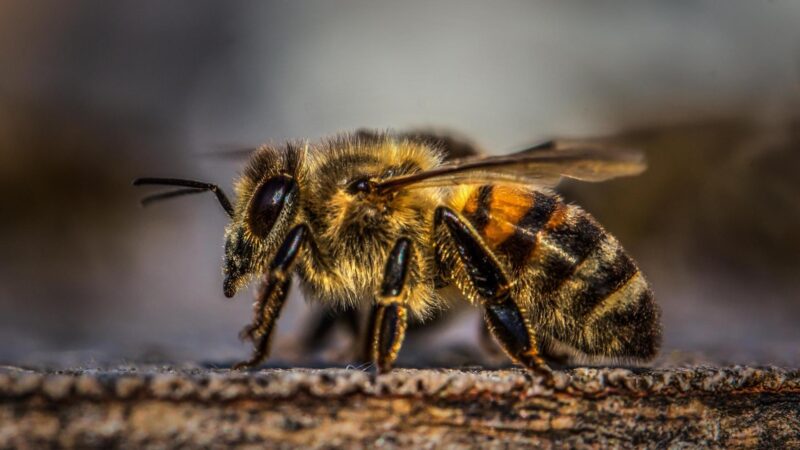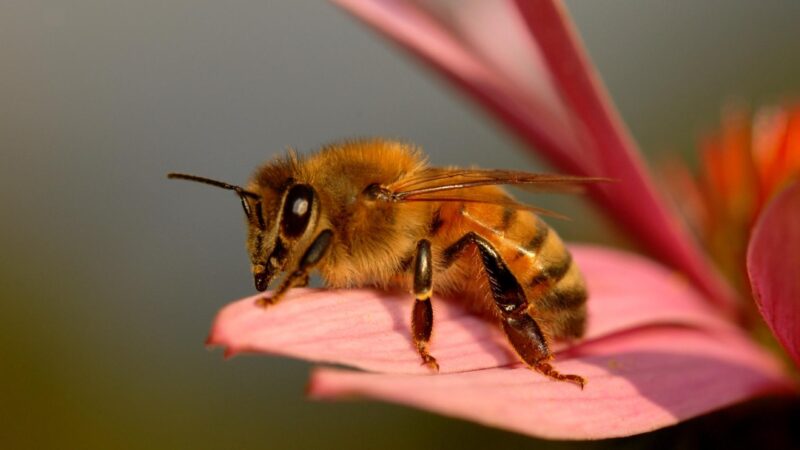Thanks to the efficiency of bee colonies, each U.S. resident can eat about 1.3 pounds of honey yearly. Honey bees pass through a productive life cycle with roles to ensure the balance of their hive ecosystems.
Honey bees undergo 4 life stages: egg, larva, pupa, and adult. Queen bees lay eggs in honeycomb cells that will hatch into larvae after three days. Then, the larvae enter their pupal stage by spinning into a cocoon. After a pupae completes its final molt, they emerge from its cells and become full-fledged adults.
To know more about the life cycle of honey bees, what happens in each stage, how life is inside the colony, and other interesting information, read this article and gain more knowledge today!
Table of Contents
What Is the Lifespan of a Honey Bee?

Queen bees usually live up to 5 years. However, their period of usefulness, which is based on the number of eggs they can produce, rarely exceeds 2 to 3 years of age. At this point, beekeepers would most likely re-queen their colonies.
On the other hand, worker bees live for 5 to 6 weeks, while drones live an average lifespan of 55 days.
Stages of the Honey Bee Life Cycle

Honey bees undergo a complete life cycle broken into 4 distinct life stages: egg, larva, pupa, and adult. This process is called complete metamorphosis, which indicates that the physical form of the bees changes significantly as larvae up until they turn into adults.
Egg
A single queen bee will lay an egg in each cell of a honeycomb. To maintain a colony, queen bees should be able to lay an average of 1,500 eggs a day. Healthy and fertile queen bees can lay up to 3,000 eggs a day during peak seasons. Egg productivity usually declines after their first year or two, but some queen bees can be productive until their third year.
Eggs that are fertilized by drones have the potential to either become a queen or a worker, while unfertilized eggs will become drones. Fertilized eggs are placed in much larger cells since queen bees are also larger than both worker bees and drones.
Larva
After three days, eggs will hatch into white larvae, legless grubs that resemble tiny white sausages. All larvae are then fed royal jelly, a protein-rich substance that is excreted from the hypopharyngeal glands of worker bees, exclusively for the first three days after hatching.
Young worker bees are given the role of becoming nurse bees and are responsible for feeding each larva during their developmental period. Larvae are usually fed every 43 seconds on average.
For larvae that are selected to become queens, they are fed more royal jelly throughout their growth and will develop into reproductive queens. Other larvae will receive bee bread or worker jelly, a substance that is a combination of nectar and pollen, and will transition into eating them on their third day. This allows them to grow into sterile workers of the hive.
All female larvae that are aged less than three days old have the potential to become queens. However, larger and more vigorous queens are chosen from the youngest larvae, which are usually less than a day old.
Pupa
This stage refers to the physical transition between the amorphous larvae and the hairy, winged adult.
After about an average of six days of feeding, larvae will elongate their bodies, spin into a cocoon (much like the caterpillar), and turn into pupates. Queen honey bees take about nine days of feeding before entering the pupa stage.
Pupates are capped inside the cell with wax. They do not eat and will usually remain undisturbed for about 12 days, depending on the type of bee.
Adult
After about 10 days, when the pupae complete its final molt, the adult bee will chew its way out of the cocooned cell and emerge into the hive where it starts its first day.
How Long Is a Bee’s Life Cycle?
Queen bees have a 16 to 19-day developmental stage from egg to adult and a life expectancy of up to 5 years after emergence. On the other hand, drones develop within 23 to 24 days and live for an average of 55 days, while workers develop within 18 to 22 days and live for 5 to 6 weeks.
Here is a tabular representation of the length of a bee’s life cycle at each stage:
| Type of Bee | Egg | Larva | Pupa | Life Expectancy After Emergence |
| Queen | Up to 3 days | 8 to 9 days | 10 to 12 days | Up to 5 years |
| Drone | Up to 3 days | 9 days | 15 days | About 55 days |
| Worker | Up to 3 days | 10 days | 12 to 15 days | 5 to 6 weeks |
What Is the Average Time for an Egg to Develop Into an Adult Bee?

Queen bees take an average of 16 to 19 days to develop and are usually the fastest to grow compared to other types of bees in the colony. All the bees in the colony help the queen grow as fast as possible to establish (in the case of new colonies) or restore (during queenless emergencies) the balance and hierarchy in the colony.
Drones take the longest time to transition into adults as they emerge in about 23 to 24 days. They remain in the pupal stage for about 15 days and generally need more time to develop due to their wider bodies and rounded abdomens compared to the typical worker bee.
Worker bees emerge as adults at around 18 to 22 days. They take longer than the queen to develop due to the differences in cell size and composition, as well as the food environment since they are only fed with regular worker jelly or bee bread.
What Is the Colony Life of a Honey Bee?
Queen
Adopts a reproductive function in the colony. Queen bees begin laying eggs in early spring and continue to produce until fall or as long as there is still available pollen for consumption. A queen bee can lay up to 1,500 to 3,000 eggs a day, depending on its productivity.
They also secrete a pheromone referred to as queen substance which affects the social, mating, and maintenance behavior of other bees in the colony. It is passed from bee to bee and is shared throughout the entire hive.
Honey bee colonies only need a single queen. If a second queen arrives in the colony, the worker bees will have to force the invading queen out of the hive, or the two queens will have to duel until one is left alive.
Beekeepers usually “re-queen” their colonies if their current queens have exceeded their usefulness or have significantly reduced their egg productivity, usually within two years.
Drone
Functions to fertilize a queen bee. They may leave and travel between colonies to search for potential queens to mate. Hence, they are only around for a few months in a year for each colony.
Drones are only produced seasonally, during the queen’s reproductive season in spring and summer, usually before new queens in the colony are reared so that there would be an ample amount of drones ready to mate with emerging queens. Each colony will have more than a thousand drones.
Before the winter season arrives, worker bees will usually force drones out of the hive and even guard the hive in case the drones return.
Worker
Smallest in size but are the most numerous. They are all biologically female but are not capable of reproducing or mating. However, in the case of a queenless colony, these worker bees will lay eggs that are left unfertilized and develop into drones.
Depending on their age, they adopt multiple roles, which include the following:
- Nurse bees. They are responsible for producing the food being consumed by larvae. They consume large quantities of nectar and pollen to produce royal jelly through their hypopharyngeal glands located at the sides of their head. Moreover, to create worker jelly, they combine royal jelly, nectar, and pollen.
- Construction workers. They secrete wax from their abdomens which are subsequently used to form honeycombs and ultimately, the hive. An ounce of wax is created by producing and consuming about two tablespoons of honey. Then, worker bees will build the wax up and add it to the combs of the hive repeatedly.
- Caretaker bees. Aside from feeding, they also tend to the other needs of their respective queens and larvae, such as capping the cells of larvae that are ready for pupation, as well as removing dirt and disposing of dead bees from the hive.
- Guard bees. They defend the hive against potential invaders and from returning drones that they already kicked out.
- Maintenance bees. They ensure the hive’s optimal conditions by cooling, heating, and ventilating when necessary.
- Foragers. A necessary role needed for the survival of every member of the hive as worker bees look for nectar and pollen in flowers, then bring it back into the hive where they are converted into honey.
What Is the Amount of Honey a Beehive Can Produce in a Lifetime?

It depends on the quality of the beehive’s foraging area, primarily if nectar is abundant and/or pollen-producing plants that worker bees can easily acquire from. However, the range is around 10 to 200 pounds in one season.
On average, a worker bee produces one-twelfth of a teaspoon of honey in their entire lifetime. It takes them 2 million flower visitations and 55,000 miles of distance to cover just to produce a pound of honey.
Colony Collapse Disorder | What Is It?
Colony collapse disorder (CCD) happens when worker bees abandon their healthy hives and leave all other types of bees in the colony to die, as they are left with no access to pollen, nectar, and honey.
Possible causes of CCD are pests and diseases, bee management, poor genetic diversity caused by the queen, use of chemicals in the colonies, presence of chemical toxins, malnutrition, or a combination of the aforementioned reasons.
Collapsed colonies are characterized by completely lacking adult bees with little to no dead bees around the hive, a capped brood, and food caches that are not taken by bees from neighboring colonies or pests.
On the other hand, collapsing colonies or colonies that are on the verge of collapsing are characterized by having a lack of adult worker bees that maintain the colony but still contain a queen and are reluctant to consume food provided by beekeepers.
Honey bees have roles to perform in their life cycle once they turn into full-fledged adults. Queens are responsible for producing eggs, drones fertilize queen bees, and workers ensure the survival of each bee inside the colony as well as maintain the optimal living conditions of the hive. Beehives will usually produce 10 to 200 pounds of honey in a season.
List of Sources
Anton, K., Grozinger, C. (2020). An Introduction to Queen Honey Bee Development. PennState Extension.
Barrett, B., et al. (2018). Honey Bees as Pollinators, Their Habitats and Products. University of Missouri Extension.
Ellis, J. (2016). Colony Collapse Disorder. University of Florida.
Farrar, C. L. (1967). The Life of the Bee. The University of Arizona – College of Agriculture & Life Sciences.
